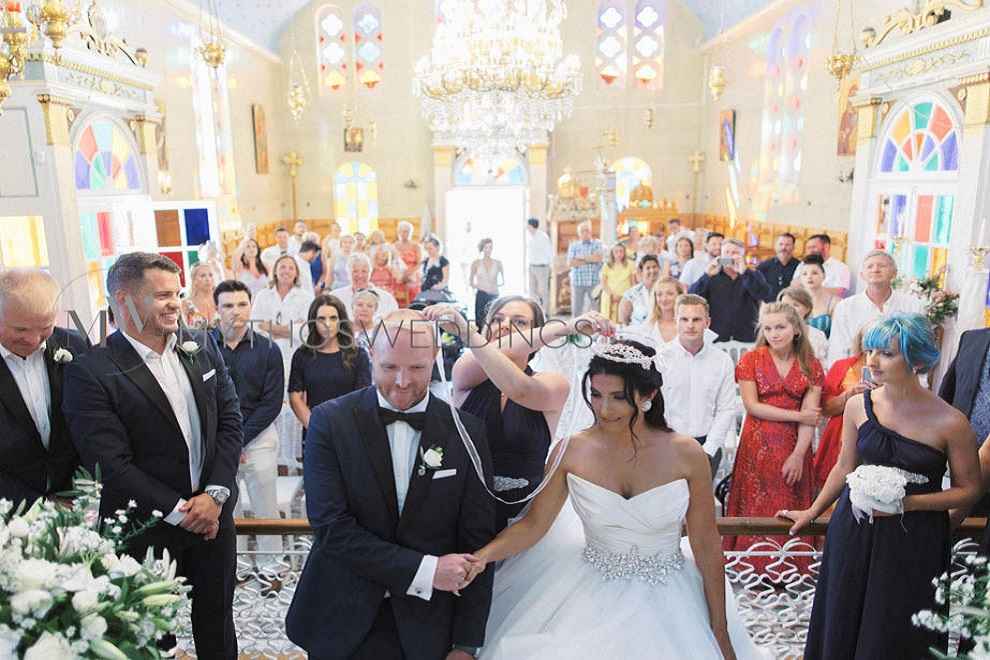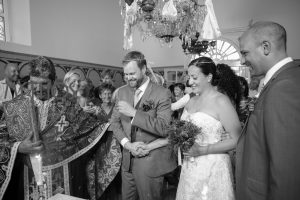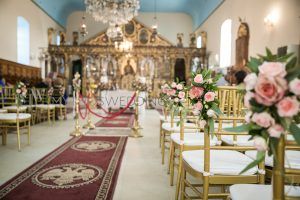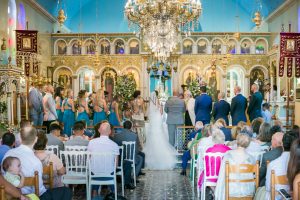
Orthodox wedding
The Greek Orthodox Wedding. A rite full of profound meaning.
An Orthodox wedding in Kefalonia is a truly mesmerizing thing. Our blessed island has 365 churches, one for each day of the year, each stunning in its own way. Stunning views, incredible architectural elements and unique locations will leave all guests in awe and bring this feeling of wonder to your Big Day.
The Orthodox wedding ceremony is full of profound symbolism and meaning. Every step of it has its own significance, making the entire process a unique experience for the couple.
The couple is led through the ceremony by their priest and their koumbaros or koumbara, a best man or woman who remains an important figure in the couple’s life. Most rituals are performed three times to represent the Holy Trinity.
There are a few necessary items your Orthodox Wedding must feature, such as the candles, the carafe of Red Wine, the cup, the crowns (stefana), the rings, etc. Your Mythos wedding planner will be able to assist you in every step of the process, be it the paperwork or the purchases and make everything easy for you!

Here are the most important elements of an Orthodox Wedding Ceremony:
Betrothal Ceremony
Orthodox weddings begin with a betrothal ceremony in which the rings are blessed. After reciting blessings and Bible passages, the priest makes the sign of the cross while holding the rings and declaring the betrothal. The priest will hold the rings in his hands while pressing them to the bride and groom’s forehead, three times each. Then, the koumbaros exchanges the rings between the couple’s fingers three times, signifying that the weakness of one will be compensated by the other. The right hand has a rich and symbolic history in the Orthodox church. Hence, the rings are usually placed on the third finger of the right hand.
Candles And Hand-Holding
After the rings are exchanged (or sometimes beforehand) the priest will light candles for the remainder of the service. The burning flames symbolize the couple’s spiritual willingness to receive God’s blessings. The priest also joins the couples right hands together while praying for their marriage. The bride and groom continue to hold hands during the ceremony as a symbol of their oneness.

Crowning
The Crowning is the centerpiece of the Eastern Orthodox marriage ceremony. Wreaths fashioned out of a number of materials, flowers, metal, wood, anything, called “stefana” in Greek serve as a symbol of glory and honor. The koumbaros presents the couple with two crowns joined by a white ribbon, symbolizing the couple’s unity. The priest places the crowns on the couple’s heads while they face the altar, then the koumbaros swaps the crowns on the couple’s heads three times. According to custom, the crowns are to stay with the couple for life (some couples are even buried in them!)

The Common Cup
After the priest reads additional Bible passages, the bride and groom take three sips of wine from a shared cup. The ritual of the common cup is based on the wedding of Cana of Galilee, where Jesus turned water into wine. The cup represents life and symbolizes the couple’s mutual sharing of joy and sorrow. As they drink wine from the common cup, they are reminded that from that moment they will share everything, doubling their joys and dividing their sorrows.
Circling The Table
Following the common cup ritual, the priest along with the koumbaros leads the couple three times around the altar on which a Bible and cross rest. This ritual dance predates Christianity, representing the dance around the Ark of the Covenant. The choir sings three hymns as the couple circles the table. In this act, the couple takes their first steps as a married couple, with the Church (through the priest) leading them. It is customary for the guests to throw rice at the couple on this point. The word rice in Greek is “Rizi”, which sound the same as “rizono”= to grow roots together. Hence, the throwing of the rice is a wish for the couple to grow roots together.

Traditional Blessings
At the ceremony’s end, the priest recites parting blessings upon the newlyweds. To the groom he may say: “Be thou magnified O Bridegroom, as Abraham, and blessed as Isaac and multiply as Jacob. Walk in peace and work in righteousness, as the commandments of God.” To the bride he may say: “And thou O Bride, be though magnified as Sarah, glad as Rebecca and multiply like unto Rachel, rejoicing in thine own husband, fulfilling the conditions of the law, for so it is well pleasing unto God.”
That was it. The couple is now husband and wife in the eyes of God and all their guests. And what more appropriate to follow a Greek Orthodox wedding than a Greek feast? Good food, Greek music, plate smashing and…Opa!

